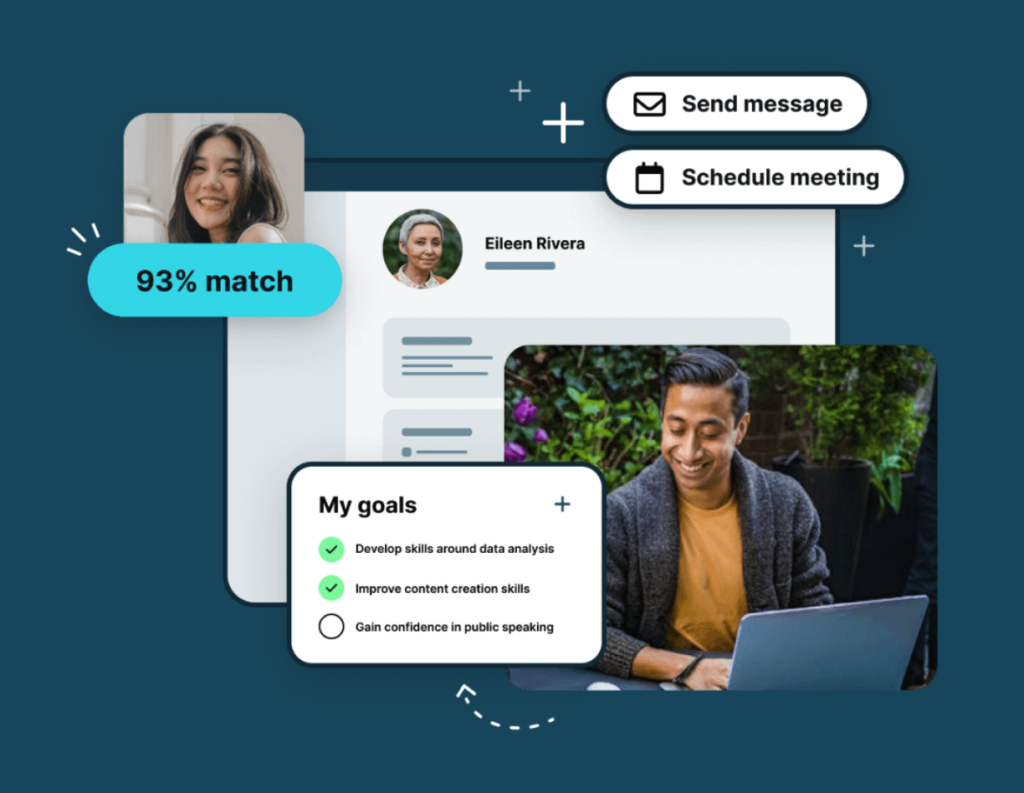Structured Mentoring
January 25, 2025 2025-01-29 9:12Structured Mentoring
Structured Mentoring
Welcome to Iasa Mentoring! As the landscape of business and technology evolves, the role of Business Technology(BT) Architects becomes increasingly critical. To support the development of these professionals, the profession needs a comprehensive mentoring method to guide the development of architect competencies and measured results.
The mentoring program aims to provide BT Architects with the knowledge, skills, and guidance needed to excel in their roles and drive successful business transformations. But it also serves to protect clients and the public from unhealthy practices and damaging technology. It ensures not just that the person has learned something but that they are qualified to provide guidance in business technology direction. Mentoring is the backbone of a healthy and mature profession.
Review the career path (https://iasa-global.github.io/btabok/career.html) and the mentoring method (https://iasa-global.github.io/btabok/mentoring.html) from the BTABoK.
What You Will Learn
- Build your Own Case Study with your Mentor.
- Master the Core Concepts
- Ways of understanding and using customer centric design approaches.
- Tools and techniques for value measurement, tradeoff analysis, design and quality attributes.
- Measurable impact to business value, project management, and delivery
- Critical skills in navigating change management from ideation to execution.
- Stakeholder management and better human dynamic skills
- Quality Attributes, Design Structures and Analysis
- Describe an architecture using multiple viewpoints to define its total shape and impacts in both functional and quality attributes
- Rigor in both design and execution environments

Mentoring Course
- CITA-F Certification Included
Sign Up Anytime
- Price - €2750
- Choose Your Mentor
- Online
Brochure
Start Anytime
The program is based on direct relationships with mentors. This means that you can start immediately after registration! No more waiting for the course to start in a few months, planning travel when you really want to get started today. You and a senior architect will immediately be connected and your mentoring begins immediately. And because you can select from mentors in all timezones, you can find someone who can work with your schedule.
Weekly Learning
Each week the mentee is assigned a certain amount of learning and homework.
- Reading Assignment from BTABoK and Industry Papers.
- Roughly 1 hr of self-paced learning.
- A homework assignment or task.
Mentor Guided Learning
The mentor will provide one to two mentoring sessions per week to discuss and help with the reading. This is a discussion session which helps the mentee understand the depth and nature of the assignment.
Mentoring Review
When the mentee has completed the assignment the mentor gives an in-depth review of the material both off-line and then with the mentee. The mentee has a chance to redo the assignment until it meets the minimum quality of the foundation or advanced education.
Final Assignment
The grading for certification is done based on completed work and a final assignment. The mentee will present their final assignment to the mentor and grading team.
Structured Focus Areas
The guided or structured mentoring that an early-stage architect would receive. This stage of learning is for architects who are getting practical experience in the building blocks of architecture. Generally this type of mentoring is focused on specific tasks and learning that the mentee needs to repeat to grow. This stage is characterized by structured learning, task assignment and repetition to grow the baseline skills of a more senior architect.

How is this different?
Structured mentoring is a completely new way to learn and grow your architecture skills. Because it is mentoring based you will work on your own materials and at your own level even if you are more senior in your career. This allows you to apply the concepts in the materials instead of simply learning them. Each week, your mentor will review your deliverables with you, providing invaluable feedback about your skills, current level and the sophistication of your approach. All of this in a structured and duplicable mentoring environment
What About my Team?
Mentors work with a group of mentees through the learning path. In open mentoring, the group is a mix of mentees from all over, so you get to learn with others from different backgrounds. But mentees can also work with a full team to mentor them through numerous shared programs.
The organization-based mentoring allows your team to work with a mentor through the same assignments but applied to their own work and in the context of your organization. You will need a group of 5 or more to request a dedicated mentoring relationship


The Platform
We have deeply customized a learning experience on the global leader of mentoring platforms, Chronus.
Our mentoring community online includes everything you need to get started immediately. Discussions, homework submission, calendar integration, self-paced reading and learning, shared file access and permissioning. You and your co-mentees will build a bond through mentoring like no other!
https://chronus.com/software/mentoring-software
Some of Our Mentors
What you'll learn
- What are architecture lifecycles, deliverables, and engagements.
- Methods to work across business, technical and management stakeholders.
- Ways of understanding and using customer centric design approaches.
- Tools and techniques for value measurement, tradeoff analysis, design and quality attributes.
- Critical skills in navigating change management from ideation to execution.
- Better ways to combine agile delivery with architecture excellence.
- How to improve an architecture practice engagement model.
Lesson 1
Introduction
The introduction gives you a long view of the entire course and introduces you to the tools and resources available to you.
Lesson 2
Architecture Core Concepts
Understand and manage the ‘Red Thread’ of architecture from innovation to maturity. This lesson introduces the core concepts from the BTABoK.
Lesson 3
Business Models
Building architectures is always understanding your clients business and that starts with where they make money. Learning business models makes for better decisions and better architecture.
Lesson 4
Customer Driven
Customer and client obsession are a part of every great architects skills. This lesson lays out the customer journey and customer personas we use to understand and feel our customers pain. These techniques work for customers, clients and stakeholders alike.
Lesson 5
Capabilities and Operations
An organization is shaped by the capabilities which drive its operations. Understanding these critical areas provides a rich ground in which to create and deliver architecture excellence as well as business language necessary to deliver successfully.
Lesson 6
Value and Benefits
Great architecture is always about value. But understanding value is hard. This lesson explores what it means to create a great solution. A great architecture. How do our clients measure success? And how do we prioritize architectural outputs and decisions? Understanding value puts you back in charge of your decisions.
Lesson 7
Roadmapping
A set of projects and products have many dependencies on each other. Through management of business cases, dependencies and tradeoffs architects create a realistic outcome based roadmap at both the strategic and product level. These techniques are essential both for management and delivery.
Lesson 8
Architecture Descriptions
Learning how to describe architectures in visual, verbal and written contexts is a major architecture skillset. Bad designs account for huge failures in projects and change. This lesson focuses on the techniques architects use to describe, document, design and ultimately deliver architecture.
Lesson 9
Stories and Requirements
Requirements, stories, use cases are all ways of saying similar things. What do we envision a system doing when it is deployed. This lesson provides a deep guide in architecturally signficant requirements. How to manage, trace, understand and make them come true!
Lesson 10
Options and Decisions
The core of rigorous design is the options and decisions which drive the outcome. Single option decisions account for a huge amount of the technical debt created in projects. This lesson focuses on making better decisions using an informed set of options.
Lesson 11
Structure and Principles
Decisions lead to design structures, these structures lead to the final shape of a system. These structures whether they deal with quality attributes, legacy integration, data movement or other structural needs are what create both longevity and value in an architecture. The principles that guide these patterns are also covered here.
Lesson 12
Architecture Assessment
Often assessment is treated as governance. However architecture assessment is very much a design process. This lesson covers ATAM and PBAAM, two architecture assessment methods which are useful in designing and building better systems shaped towards both structure and requirements.
Lesson 13
Roles and Agility
This lesson focuses on three majore components of becoming a great architect. Understanding the competencies of an architect. How to employ those competencies to roles in architecture. How to apply architecture to agile contexts.
Lesson 14
Stakeholder Driven Approach
One of the most critical functions of an architect is dealing with stakeholders and expectations. The stakeholder driven approach in the BTABoK provides a huge benefit in managing and succeeding in complex business ecosystems. And this lesson gives you a deep toolset for stakeholder success.
Lesson 15
Architecture Deliverables
Beyond a project there are dozens of expected deliverables from architects. These include types of business and technical evaluations and shared assets, governance, research in to new technologies and much more. These deliverables are as much a part of an architecture practice as project or program work.
Lesson 16
World Class Engagement
How can you build a world class architecture practice? How do you take the techniques learned in Core, the BTABoK and other Iasa assets and utilize them to the best advantage of the architects in your organization and your clients outcomes? This lesson dives into taking all of these techniques and applying them the day you get back to the job!
Teaching Modalities
- 10 weeks
- 2 hrs Online Self-Paced
- 2 hrs Homework
- 2 hrs Mentor meeting to review homework
- Final presentation to mentor for grade
- Online Instructor Reviewed
- Homework
- Homework – Miro
- Course Material – Chronus

Maintaining your IASA certification
Earning your IASA certification is a big achievement—we’re here to help you maintain it. Continuous skill growth that extends beyond certification is critical to fueling your career and your impact. IASA certification holders need to earn
- Learning
- Teaching others
- Presenting
- Reading
- Volunteering
- Content creating



